So, you're looking at a new electric bike but have that one big question nagging you: are electric bikes even street legal?
The short answer is yes, in most places. But it’s not exactly a free-for-all. What gets a green light in one state or country could land you in hot water in another, all depending on things like motor power, speed, and whether it has a throttle.
Your Guide to E-Bike Street Legality
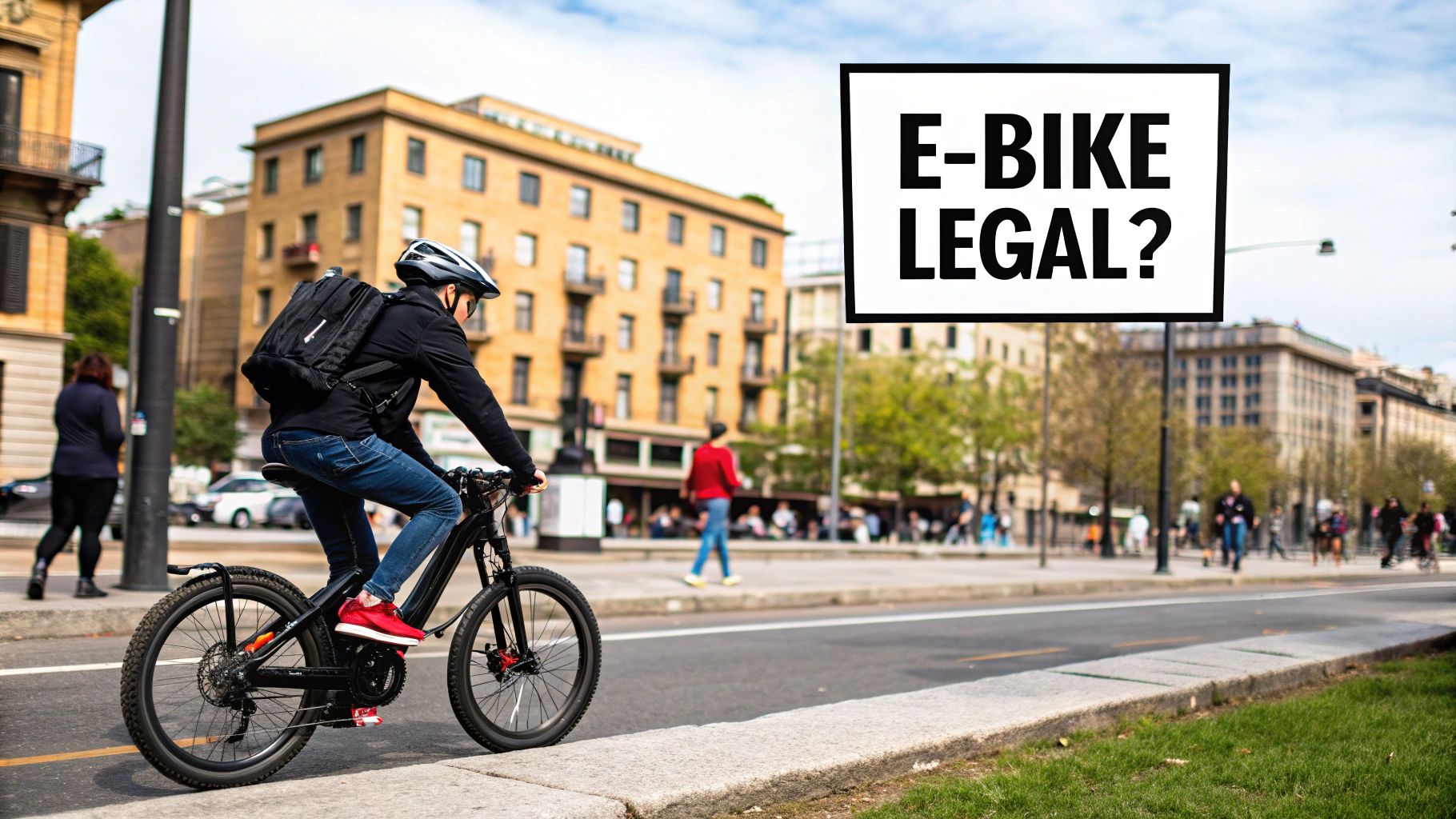
Trying to figure out e-bike laws can feel like learning a new set of traffic rules for every city you ride through. The good news? The core ideas are pretty simple once you get the hang of what regulators are actually looking for. They're basically trying to draw a clear line between a bicycle that gives you a little boost and a full-blown motor vehicle.
Think of it like this: an e-bike is "street legal" if the law treats it just like a regular bicycle. That means no license, no registration, and no special insurance needed to ride it on public roads and bike paths. Whether your bike gets this status comes down to three key things.
The Core Legal Factors
- Maximum Motor Power: This is the muscle of your motor, measured in watts (W). Most places put a hard cap on this to keep bikes from getting too powerful.
- Top Assisted Speed: This is the speed where the motor has to automatically cut out. You can always pedal faster on your own, but the motor won't help you past this point.
- Throttle vs. Pedal-Assist: A throttle works like a motorcycle's—twist it and you go, no pedaling required. Pedal-assist (or "pedelec") only kicks in when you're actually pedaling.
An electric bike’s legality isn't about the brand or how cool it looks; it's all about its performance specs. Staying within the official limits for power and speed is what keeps you on the right side of the law.
When you look around the world, you’ll see a real patchwork of rules. The US and Australia, for example, have taken different paths. In the United States, the laws are generally more relaxed, allowing for more powerful 750W motors and throttles on most classes of e-bikes.
Down under in Australia, things are much stricter, aligning more closely with European standards. They stick to a 250W motor limit and require the bike to be pedal-assist only to be considered a legal bicycle. You can dive deeper into these global e-bike laws on Hovsco.com.
Let's break down these differences so you know exactly what to look for.
E-Bike Legality At A Glance (US vs. Australia)
Here’s a quick cheat sheet to see how the rules stack up. This table covers what it takes for an e-bike to be treated like a standard bicycle—no license or registration needed.
| Region | Max Motor Power | Max Assisted Speed | Throttle Rules |
|---|---|---|---|
| USA | 750W | 20-28 mph (32-45 kph) | Allowed on Class 2 & 3 (varies by state) |
| Australia | 250W | 15.5 mph (25 kph) | Not allowed (must be pedal-assist only) |
As you can see, the differences are significant. The US is far more permissive on power and speed, while Australia prioritizes a lower-power, pedal-first approach. These are the fundamental distinctions that will shape your buying decision.
Understanding The E-Bike Classification System
Not all electric bikes are built the same, which is why regulators had to step in and create a few different classification systems to keep things organized. Think of it like coffee sizes at your local cafe—a small, medium, and large are all still coffee, but they offer a totally different experience. In the same way, e-bike classes help define what a bike can do and where it can go.
The United States uses a popular 3-class system. Over in Australia, they've taken a more unified approach. Getting a handle on these categories is your first step to making sure your ride is street-legal.
The American Three-Class System
In the U.S., e-bikes are sorted into three neat tiers based on two key things: how fast the motor will help you go, and whether you can get that power without pedaling (using a throttle). This setup gives riders a ton of options, but it also means you’ve got to pay a little closer attention to local rules.
This infographic breaks down the hierarchy pretty clearly.
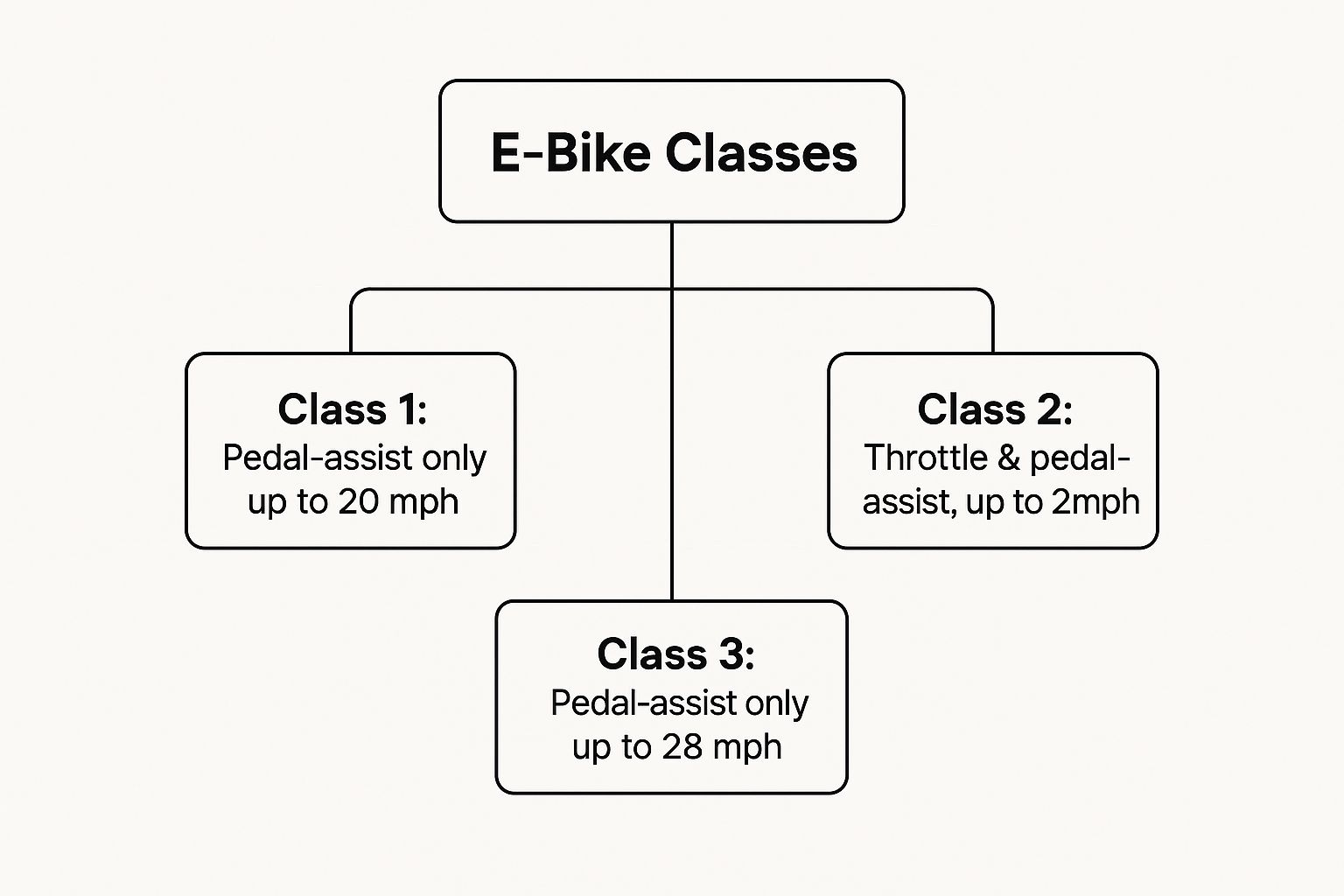
As you can see, the main things that separate one class from another are the top assisted speed and that all-important throttle.
Here’s a quick look at what this all means for you on the road.
To make this super clear, here’s a table that lays out the differences side-by-side.
The US 3-Class E-Bike System Explained
| Class | How The Motor Works | Max Assisted Speed | Throttle Included? |
|---|---|---|---|
| Class 1 | Provides a boost only when you're pedaling. | 20 mph | No |
| Class 2 | Can be powered by a throttle, no pedaling needed. | 20 mph | Yes |
| Class 3 | Provides a boost only when you're pedaling. | 28 mph | No (Usually) |
So, what does this actually mean for your ride?
-
Class 1: This is your classic pedal-assist e-bike. The motor kicks in to help you out, but only when you’re pedaling. Once you hit 20 mph, the assistance cuts off. These are the most widely accepted e-bikes, and you’ll usually see them allowed on bike paths and trails. Want to dive deeper? Check out our guide on what is a Class 1 ebike.
-
Class 2: These bikes also top out at 20 mph, but they have a secret weapon: a throttle. This means you can get a burst of power without pedaling at all, which is a lifesaver for getting a quick start at a red light or cruising up a small hill.
-
Class 3: These are the speed demons of the e-bike world. The motor keeps helping you all the way up to 28 mph, but just like Class 1, it's pedal-assist only—no free rides from a throttle. Because they're faster, you'll find they often face more restrictions and are typically kept to roads and dedicated on-street bike lanes.
The Australian 'Pedelec' Standard
Down under, the approach is much simpler and stricter. Australia doesn't use the multi-class system found in the US. Instead, they have one main category for legal e-bikes, often referred to as 'pedelecs'.
To be street-legal as a bicycle in Australia, an e-bike's motor must be 250 watts or less, and power assistance must cut out at 15.5 mph (25 km/h). Crucially, the bike must be powered by pedal-assist only. Throttles are not permitted.
If an e-bike has a motor more powerful than 250W or includes a throttle, it's no longer considered a bicycle. It falls into the category of a motor vehicle and requires registration, a license, and insurance, just like a moped or motorcycle. This unified standard applies across all states and territories, making it easy to know if your ride is compliant anywhere in the country.
Decoding E-Bike Rules in the US
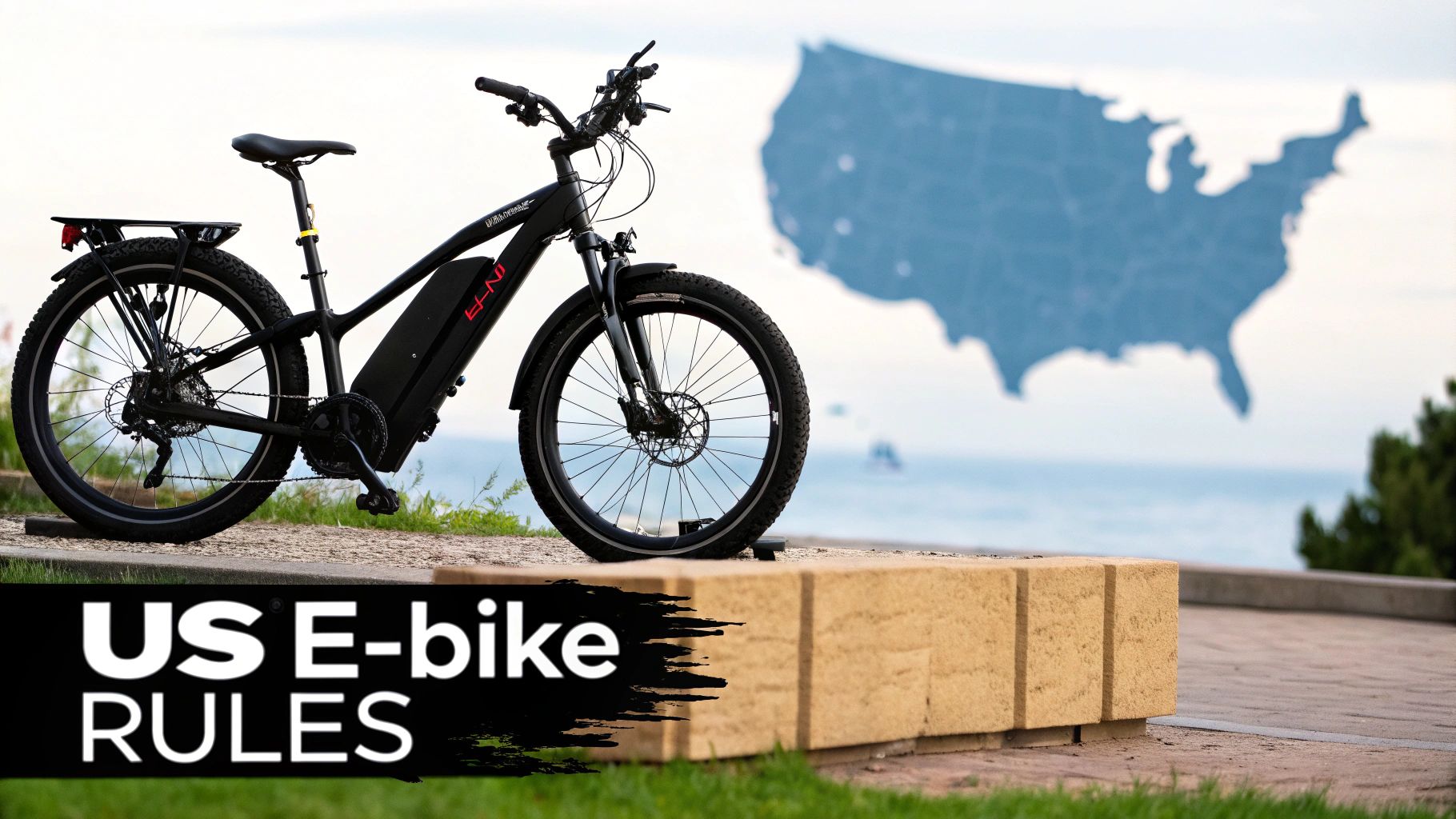
Trying to figure out American e-bike laws can feel like driving through a country where the traffic rules change every time you cross a state line. It’s a real head-scratcher. While there’s a federal law that gives a baseline definition, each state gets the final word, creating a messy patchwork of regulations that can be tough to navigate. Getting a handle on this system is the first step to knowing if your bike is actually street legal.
So, at the federal level, things are pretty simple. An e-bike is defined as a two- or three-wheeled vehicle with a motor under 750 watts that stops helping you at 20 mph. But that’s just a starting point. The state laws are what really count for your day-to-day rides. Most states have jumped on board with the 3-class system we talked about, but the way they interpret and enforce it can be wildly different.
This patchwork of rules is happening while e-bikes are absolutely exploding in popularity. By 2023, there were an estimated 300 million pedal-assist bikes on roads around the globe. Here in the US, sales hit nearly 900,000 units back in 2021, which shows just how much people want electric options—often faster than the lawmakers can keep up. If you're curious about this boom, you can dive into some fascinating e-bike facts and statistics.
State-By-State E-Bike Rule Variations
This is where the real confusion kicks in. What's perfectly fine in one state could get you a ticket in the next, especially when it comes to where you're allowed to ride each class of e-bike. These local rules are what truly decide if your electric bike is street legal on a particular bike path, trail, or road.
Let's look at a few examples to see just how different things can be:
- California: The Golden State fully embraces the 3-class system. Class 1 and 2 e-bikes can pretty much go wherever regular bikes can, including most bike paths. But the zippier Class 3 bikes? They’re stuck on roadways and on-street bike lanes. Plus, you have to be at least 16 and wear a helmet to ride one.
- New York: New York also uses the class system, but with its own flavor. Class 3 e-bikes face way more restrictions and are even banned in some cities, like NYC. You have to wear a helmet on a Class 3, and anyone under 21 needs one for Class 1 and 2 bikes, too.
- Florida: Down in Florida, the law is a bit more relaxed. All three classes are generally allowed on streets, bike lanes, and paths. The catch? Local towns and cities can make up their own rules, so you still have to check the local ordinances before you ride.
The big takeaway for anyone riding in the US is this: "street legal" completely depends on where your wheels are. Always, always check your specific state and city regulations. Local rules almost always trump the federal guidelines.
Common State-Level Regulations To Know
It's not just about which path you can take. States often have a whole list of other rules for e-bike riders, all designed to keep you and everyone else safe. Ignoring these can lead to fines, even if your bike itself fits the legal definition.
Here are a few key rules to keep an eye out for:
- Age Restrictions: Many states say you have to be a certain age—often 14 or 16—to operate an e-bike, especially the faster Class 3 models.
- Helmet Laws: While it’s always a good idea to wear one, it’s not always the law for adults on slower e-bikes. However, helmets are almost always mandatory for riders under a certain age (usually 18) and for all riders on Class 3 bikes.
- Labeling Requirements: In states that use the 3-class system, manufacturers are required to put a sticker on the bike. This label has to clearly state the bike's class, motor wattage, and top assisted speed so law enforcement can see it at a glance.
Riding in Australia? Here's the Deal.
If you think the US e-bike laws are a tangled mess, you’ll find a much more straightforward system down under. Australia has a clear, nationally consistent set of rules, which makes life a whole lot simpler for riders.
This whole system is built around a single, crucial concept: the pedelec, or electrically power-assisted cycle. If your bike fits the pedelec rules, the law sees it as a regular old bicycle. That means no license, no registration, and no mandatory insurance. It's the golden ticket for e-bike freedom across the country.
The Two Golden Rules for Australian Compliance
To make sure your e-bike is legally a bicycle and not a moped in disguise, you just have to remember two key numbers. Get these wrong, and you're suddenly in a world of legal trouble that requires a license, insurance, and more.
Here’s what you need to know:
- Motor Power: The motor can’t have a continuous power output over 250 watts.
- Top Assisted Speed: The motor has to stop helping you once you hit 15.5 mph (25 km/h).
You can absolutely pedal faster than 25 km/h—that’s all you! But the motor itself has to legally bow out at that speed. Any e-bike sold as a "pedelec" should already follow these rules straight out of the box.
The second your e-bike motor goes past 250W or gives you a boost beyond 25 km/h, it stops being a legal pedelec. Legally, it's now a motor vehicle, and you'll need a license, insurance, and a proper helmet to ride it on public roads.
The Deal with Throttles in Australia
This is a critical point of difference from the US. In Australia, a legal electric bike must be pedal-assist only. Throttles—those twist grips or levers that let you move without pedaling—are strictly forbidden.
The entire principle of a pedelec is that the motor assists your pedaling effort; it doesn't replace it. If your bike can be propelled by a throttle alone, it is not considered a bicycle under Australian Road Rules and cannot be ridden on public roads or paths without being registered as a motor vehicle.
Other Must-Knows for Aussie Riders
A couple of other simple rules keep you on the right side of the law. There are no specific age restrictions for riding a compliant e-bike, but riders must follow the same road rules as conventional cyclists, including wearing an approved helmet at all times.
And don't forget the "pedal" part of the name. The bike must have working pedals that are the primary means of propulsion. If it’s powered only by a motor, it's not a pedelec. Simple as that.
Riding Safely And Staying Compliant
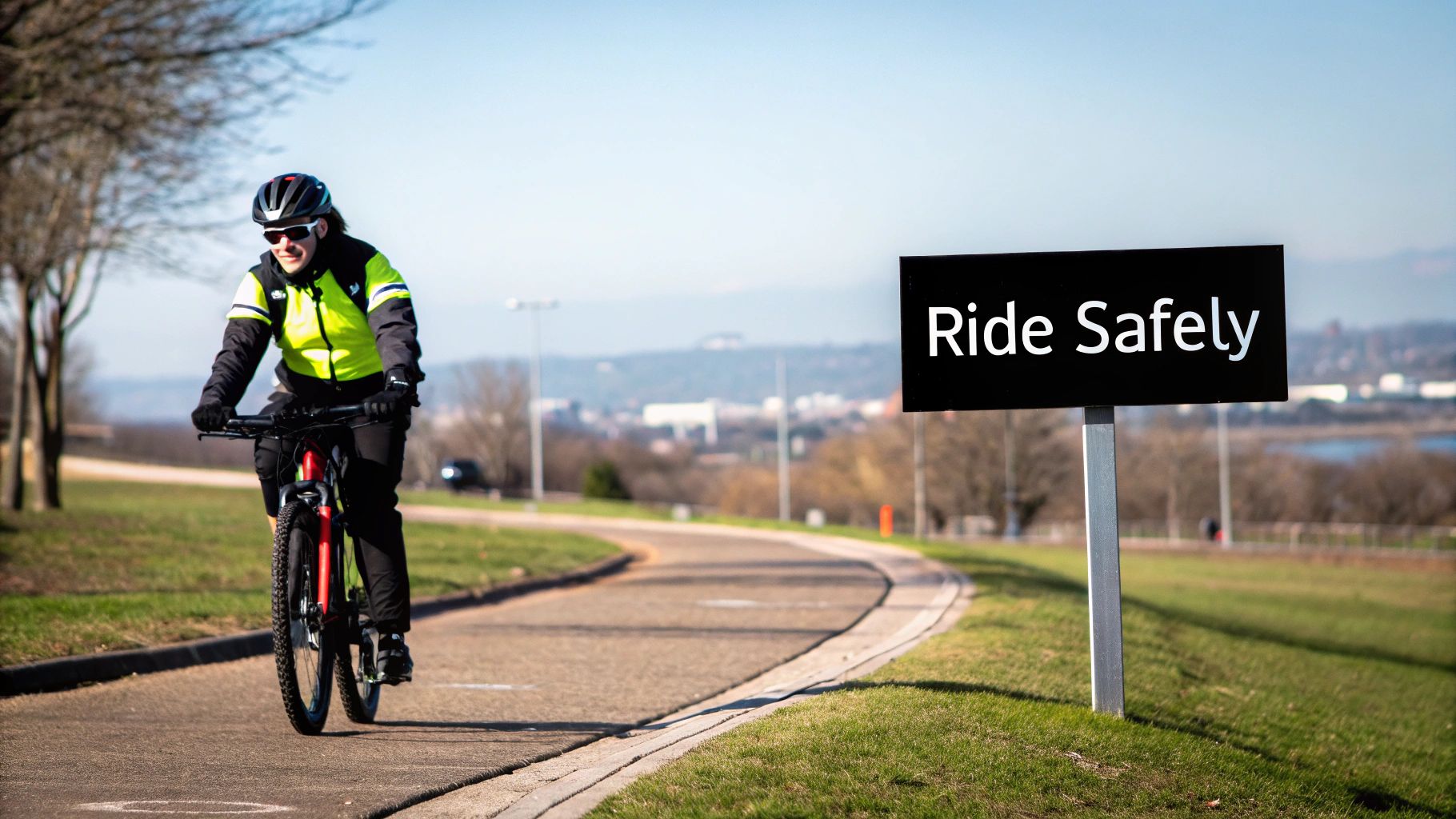
Knowing your e-bike’s motor specs and the local laws is step one. But making sure your e-bike is truly street legal is about more than just the technical stuff—it's about riding responsibly and keeping yourself and everyone else safe. As more e-bikes hit the streets, this "unwritten rulebook" of smart riding is more critical than ever.
One of the biggest behind-the-scenes safety issues is the battery. As e-bikes have boomed, we've unfortunately seen a scary rise in fires caused by shoddy, uncertified lithium-ion batteries. Always, always use the charger that came with your bike. It's also a smart move to look for UL-certified batteries, which tells you they've passed rigorous safety tests.
Sadly, the spike in e-bike popularity has also meant more accidents. In the U.S. alone, emergency room visits for e-bikes and other micromobility products shot up from 34,000 in 2017 to over 77,000 in 2021. You can dig into these electric bike accident statistics to get a clearer picture of the risks.
The Unwritten Rules of the Road
Beyond the hardware, how you ride is what really matters. Safe riding is all about being predictable and courteous. When you ride this way, you help build goodwill between e-bike riders, traditional cyclists, and pedestrians sharing the same space.
Here are a few essential tips to get you started:
- Mind Your Speed: Just because your bike can hit 20 or 28 mph doesn't mean it’s always a good idea. Slow down and match your speed to your surroundings, especially on a crowded bike path or when you're near people on foot.
- Be Predictable: Use hand signals for turns and stops. Don’t make sudden moves—drivers and other riders often misjudge an e-bike's speed, so jerky movements can catch them completely off guard.
- Make Some Noise: E-bikes are surprisingly quiet. A simple bell or a friendly "on your left" before you pass is a game-changer for letting people know you're coming.
Your job as a rider goes way beyond just following the law. When you ride with awareness and respect, you help make sure e-bikes are seen as a safe and welcome part of our communities.
Essential Gear for a Safer Ride
Some gear is just plain smart, whether the law requires it or not. Investing in a few key pieces of equipment is one of the best things you can do to protect yourself and make sure you’re seen.
A high-quality, properly fitted helmet is non-negotiable. It is, without a doubt, the single most important piece of safety gear you can own. Bright, reflective clothing and powerful front and rear lights also make a massive difference in how visible you are to drivers, especially at dawn, dusk, or on a gloomy day.
For more ideas on what to get, check out our guide on the best electric bike accessories to build out your complete safety kit.
Got Questions About E-Bike Laws? We've Got Answers
Even after breaking down all the rules, you might still be scratching your head about a few things. That’s totally fine—e-bike laws can feel like a tangled mess. Let's clear up some of the most common questions riders have about staying on the right side of the law.
Do I Need a License or Insurance for My E-Bike?
For the most part, the answer is a relieving no. As long as your e-bike plays by the rules—meaning it fits the pedelec definition in Australia or falls into Class 1, 2, or 3 in the US—you don't need a license, registration, or special insurance. The whole idea is to treat these bikes just like regular pedal-powered bicycles.
But here’s the catch: the moment your bike’s motor or speed crosses those legal lines, it's no longer seen as a bicycle. It gets reclassified as a moped or even a motorcycle. If that happens, you’ll have to jump through all the hoops of a motor vehicle owner, like getting a license plate, buying insurance, and holding the right kind of driver's license.
Can I Ride on Sidewalks and Bike Paths?
This is where things get really local, and the answer changes drastically depending on where you are. In Australia, it's pretty straightforward. E-bikes are treated like their non-electric cousins: they're welcome on bike paths but are generally a no-go on sidewalks (rules can vary by state) to keep pedestrians safe.
The US, on the other hand, is a real patchwork of rules. Many cities and states ban the faster Class 3 e-bikes from anything but on-road bike lanes. The slower Class 1 and Class 2 e-bikes often get the green light for multi-use paths, but sidewalk riding is almost always forbidden in busy downtown or commercial areas.
The golden rule here? Always, always check local rules. Your state, city, county, or even the park authority gets the final say. Keep an eye out for signs at trailheads and path entrances before you start your ride.
What Happens If My E-Bike Is Too Powerful?
Riding an e-bike that’s over the legal power or speed limit on public roads is a gamble you don’t want to take. If you get pulled over, the authorities could treat your bike as an unregistered motor vehicle, and the penalties can be pretty stiff.
You could be looking at:
- Hefty Fines: These can easily run into hundreds of dollars.
- Bike Impoundment: Yep, they can take your bike away.
- Points on Your License: In some places, you could even get points on your driver's license.
Worse yet, if you’re in an accident on an illegally powerful bike, your lack of vehicle insurance could land you in a world of legal and financial trouble. The smart move is to keep those high-power beasts on private land, with the owner's permission. And don't forget, proper maintenance is part of staying safe; check out our guide to maximizing your electric bike battery life to keep things running smoothly.
Are There Age Restrictions for E-Bikes?
Yes, though this varies. In Australia, there are generally no specific age restrictions for riding a compliant e-bike, but cyclists of all ages must follow road rules, including mandatory helmet use.
Stateside, the age limits can vary by state and even by e-bike class. For example, some states require you to be at least 16 years old to ride a zippier Class 3 e-bike. Helmet laws are often tied to age, too, with many states making them mandatory for anyone under 18, no matter what kind of e-bike they’re on.
Ready to hit the road on a fully compliant, street-legal electric bike? At Punk Ride, we've handpicked a killer selection of top-tier e-bikes that meet all the US rules. Check out our collection and find the perfect ride for your urban adventures at https://www.punkride.com.




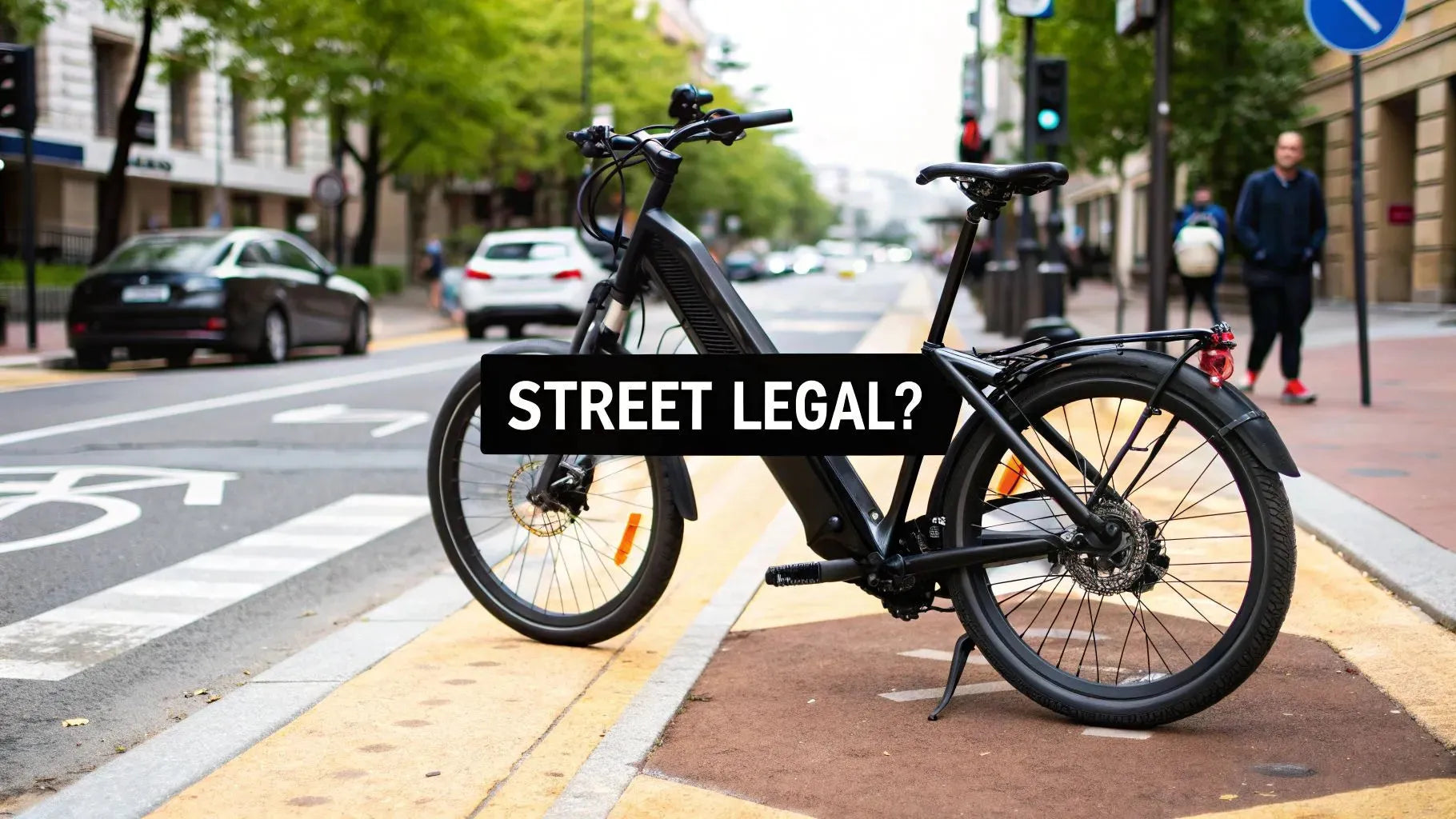
Share:
Are Electric Bikes Worth It? The Ultimate Guide
A Guide to Electric Scooter Laws By State